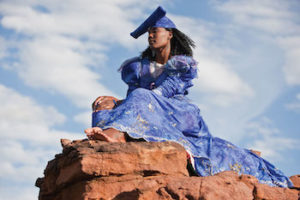
*The Herero community is celebrated on this date in 1200. Also known as Ovaherero, they are a Bantu ethnic group inhabiting parts of Southern Africa. There were an estimated 250,000 Herero people in Namibia in 2013. They speak Otjiherero, a Bantu language. Though the Herero primarily reside in Namibia, there are also significant populations in Botswana and Angola. In Botswana, the Herero or Ovaherero are mainly found in Maun and some villages surrounding Maun. Among other villages are Sepopa, Toromuja, Karee, and Etosha. Some of them are at Mahalapye. In the Southeastern part of Botswana, they are at Pilane. There are also a few in the Kgalagadi South, such as Tsabong, Omawaneni, Draaihoek, and Makopong Villages.
Ovaherero is known as a bold culture keeper. The big ball gown dress and the headgear are the main wear for women, while men are mostly seen with leather hats and walking sticks. Unlike most Bantu, who are primarily subsistence farmers, the Herero are traditionally pastoralists. They make a living tending livestock. Cattle terminology used among many Bantu pastoralist groups testifies that Bantu herders originally acquired cattle from Cushitic pastoralists inhabiting Eastern Africa. After the Bantu settled in Eastern Africa, some Bantu nations spread south. Linguistic evidence also suggests that the Bantu borrowed the custom of milking cattle from Cushitic peoples through direct contact with them or indirectly via Khoisan intermediaries who had acquired domesticated animals and pastoral techniques from Cushitic migrants.
Organization
The Herero people comprise several subdivisions, including the Himba, Tjimba Mbanderu, and Kwandu. Groups in Angola include the Mucubal Kuvale, Zemba, Hakawona, Tjavikwa, Tjimba, and Himba, who regularly cross the Namibia/Angola border when migrating with their herds. However, the Tjimba, though they speak Herero, are physically distinct indigenous hunter-gatherers.
The leadership of the Ovaherero is distributed over eight royal houses, among them:
· Ovaherero Traditional Authority of the Ovaherero Kingdom
· Maharero Royal Traditional Authority, chief Tjinaani Maharero
· Zeraeua Royal Traditional Authority at Otjimbingwe
· Ovambanderu Royal Traditional Authority, chief
· Onguatjindu Royal Traditional Authority at Okakarara
Since conflicts with the Nama people in the 1860s necessitated Ovaherero unity, they also had a paramount chief ruling over all eight royal houses. However, there is an interpretation that such paramount chieftaincy violates the Traditional Authorities Act of 2000.
The Herero language (Otjiherero) is the main unifying link among the Herero people. It is a Bantu language and part of the Niger-Congo family. Within the Otjiherero umbrella are many dialects, including Oluthimba or Otjizemba—the most common dialect in Angola—Otjihimba, and Otjikuvale. These differ mainly in phonology and are largely mutually intelligible, though Kuvale, Zemba, and Hakaona have been classified as separate languages.
Standard Herero is used in Namibian media and is taught in schools nationwide. Herero people believe in Okuruo (holy fire), a link to their ancestors to speak to God and Jesus Christ on their behalf. Modern-day Herero are mostly Christian, Catholic, Lutheran, and Born-again Christians.